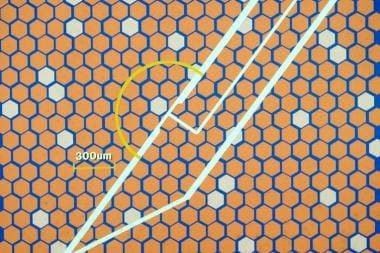Overview
Single-fiber electromyography (SFEMG) is a selective EMG recording technique that allows identification of action potentials (APs) from individual muscle fibers. It was initially described in the early 1960s but gained popularity after the publication of Stålberg and Trontelj’s monograph, Single Fibre Electromyography, in 1979.
The selectivity of the technique results from the small recording surface (25 µm in diameter), which is exposed at a port on the side of the electrode, which is 3 mm from the tip (see image below). The selectivity of the recording is further heightened by using a high-pass filter of 500 Hz. Identification of APs from individual muscle fibers by SFEMG uniquely allows measurement of 2 features of the motor unit: fiber density and neuromuscular jitter.
Diagram of a single-fiber electromyography electrode within a motor unit. Light-colored symbols indicate muscle fibers belonging to one motor unit. The electrode is positioned to record the action potential from one muscle fiber with maximum amplitude. In this example, no other muscle fibers from the same motor unit are within the recording territory of the electrode (yellow semicircle).
Normal jitter values
Reference jitter values have been determined for many muscles.
Jitter increases slightly with age in normal subjects.
A study is abnormal if the mean (or median) jitter exceeds the upper limit for the muscle, or if more than 10% of pairs or endplates have increased jitter or blocking.
Jitter less than 5 µs is seen rarely in voluntarily activated SFEMG studies in normal muscles and more often in myopathies.
These low values probably result from recordings that are made from split muscle fibers, both branches of which are activated by a single neuromuscular junction.
These values should not be included in assessments of neuromuscular transmission.
The MCD value that is measured during axonal stimulation is less than that measured during voluntary activation of the same muscle; the latter comes from only single endplates.
Reference values for jitter during axonal stimulation have been determined for the extensor digitorum communis (EDC) and orbicularis oculi muscles.
For other muscles, the normative values for stimulation jitter can be obtained by multiplying the values for voluntary activation by a conversion factor of 0.8.
MCD values less than 5 µs that are obtained during stimulation SFEMG occur when the muscle fiber is stimulated directly; these values should not be used for assessing neuromuscular transmission.

